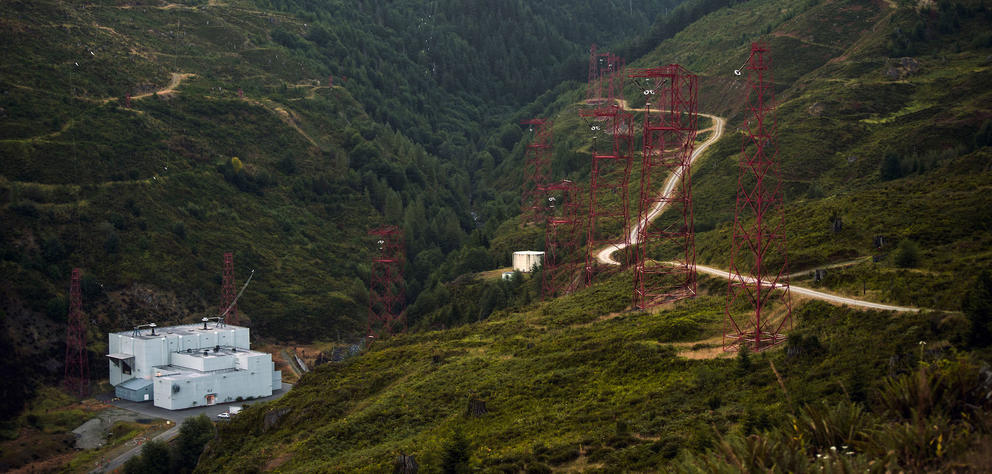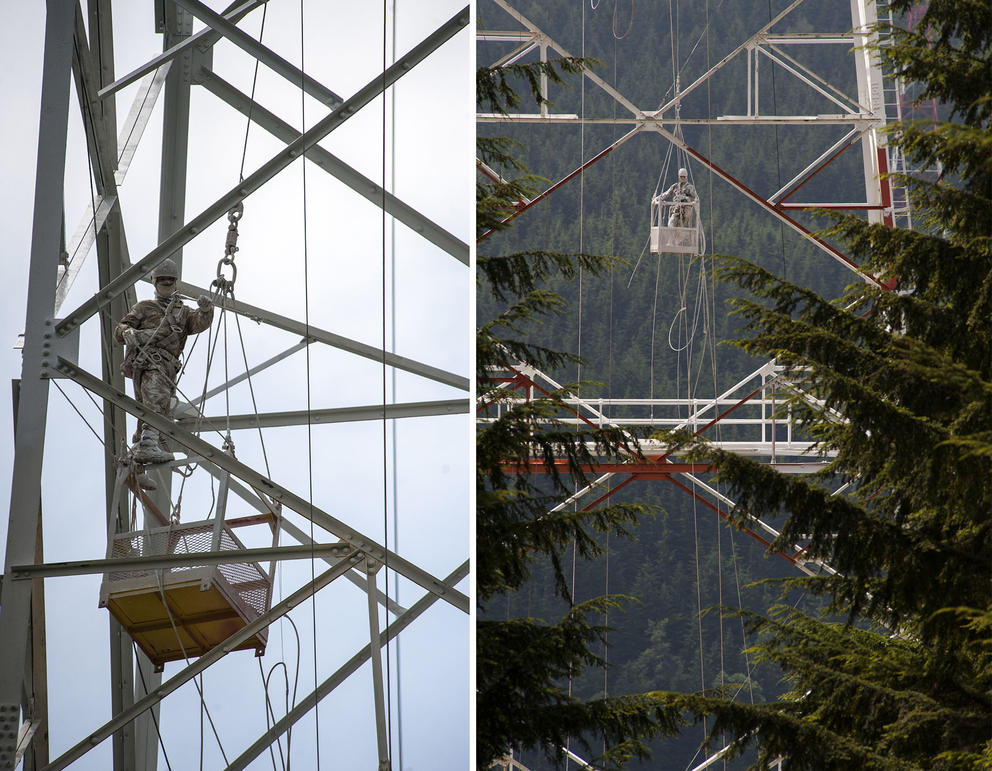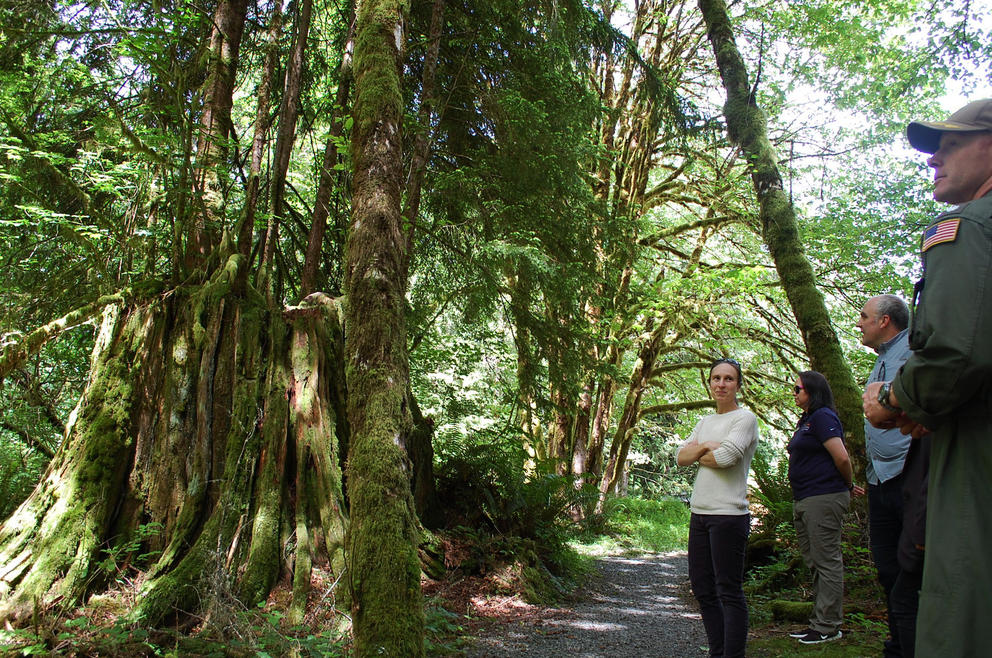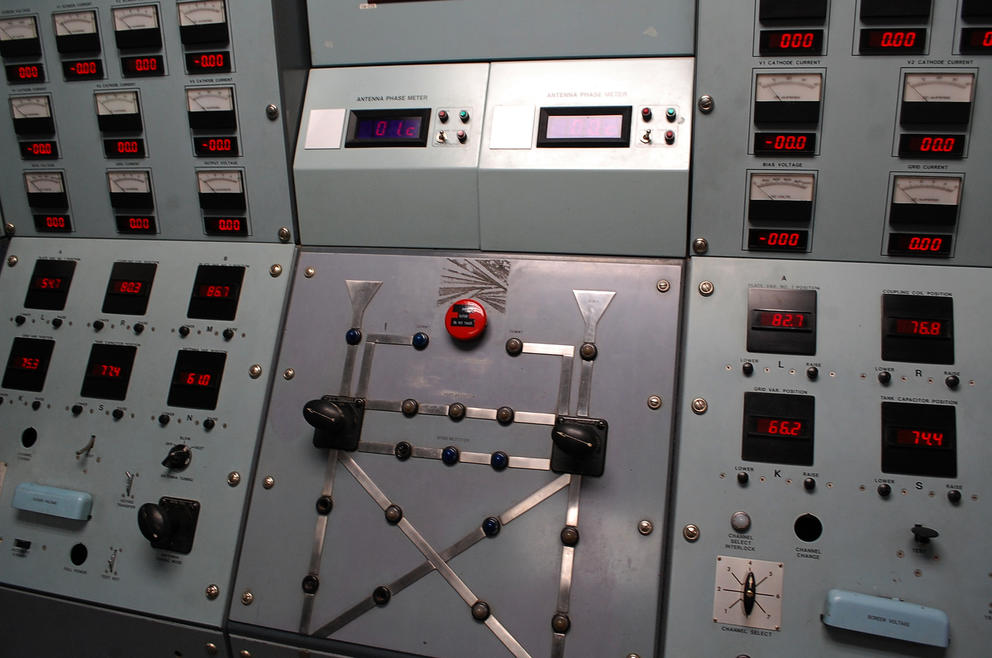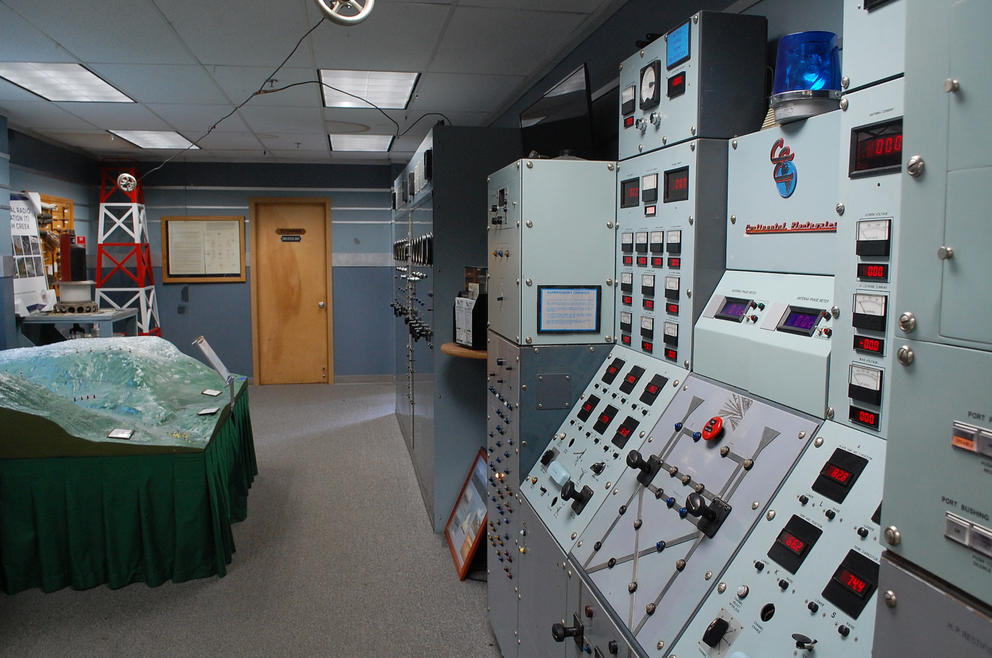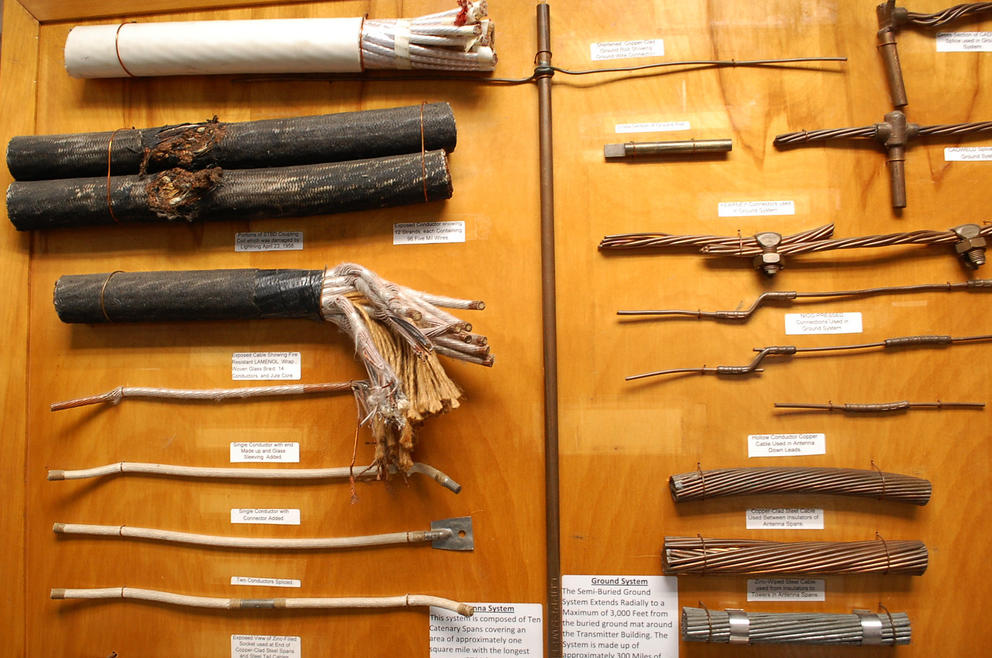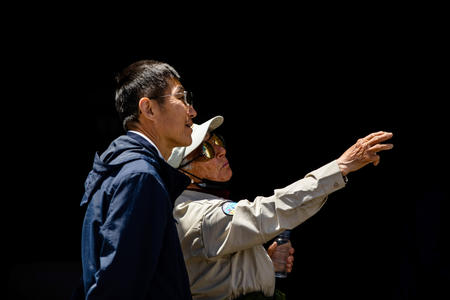From as close as you can legally get, the view of these towers isn’t especially dramatic. You’d be forgiven if you mistook them for power transmission lines or some ginormous cell phone communications structure.
Many people driving the Mountain Loop Highway toward their summer day hikes likely never notice these towers at all.
But the Russian military has.
According to reports published in 2019, Russia has selected this unremarkable spot in the Cascade foothills as one of its first-priority nuclear targets.
Because tucked above a quiet U.S. Navy recreation facility that’s used for camping and fishing sits a 1 million-watt radio transmitter nearly a mile wide that can communicate with submarines thousands of miles away in the depths of the Pacific Ocean.
Chris Immele, a painter from Tower Inspection Inc., on one of the 35 antenna towers located at Jim Creek Naval Radio Station in 2012. The antenna towers are 200 ft tall and are atop the mountainsides where the top elevation is near 3,000 ft. The towers have to be stripped and painted in order to keep the metal towers in good working order. (U.S. Navy photo by Robin Hicks/Released)
Though the Navy doesn’t officially say so, it’s generally presumed that the 5,000-acre facility known as Naval Radio Station Jim Creek would send an encrypted message to start a nuclear Armageddon, were that ever to happen.
Jim Creek is also a lovely place with salmon-laden streams and centuries-old forests where cute, mysterious seabirds known as marbled murrelets build their nests and raise fluffy little chicks.
Alicia Higgs, natural resources manager for the Jim Creek facility and several other Navy properties on the West Coast, said there are significant ancient forests here that make great habitat for murrelets. “It's one of the last remaining patches of Puget Sound lowland old growth. This area has been pretty well hammered, so it’s a really special forest,” she said.
Higgs notes that while much of this Navy property has been logged, 275 acres of mature forest in a gorge near Twin Lakes has been permanently protected since the late 1990s. Some of those trees, which include western hemlock, Douglas fir, western red cedar – and one of the largest existing stands of Sitka spruce in the Puget Sound basin – are over 1,000 years old and up to 12 feet in diameter.
Those big trees are the perfect nesting habitat for murrelets, which are currently listed as threatened under the Endangered Species Act and avoid predators by building their nests high in the branches of the ancient trees, says Higgs. Though they spend most of their lives in the water, they’re also speedy flyers. “They actually make a sound like a little jet,” she added. “They go very fast – the only comparable bird is a peregrine falcon.”
Jim Creek’s executive officer, Cmdr. Matthew Loverink, said he thinks he spotted one of these top-gun birds while out on a walk at the facility last year. “There was this streak of something,” Loverink said with a disarming grin, “and then it disappeared into the trees.”
Wildlife biologist Alicia Higgs (left) and Jim Creek executive officer Matthew Loverink (right) admire an old growth cedar stump on a trail in the naval facility’s recreation area. In addition to providing hiking, camping, and fishing for active members of the military and their guests, a 275-acre preserve at Jim Creek protects some of the last lowland old growth forest in the Puget Sound basin. (Andrew Engelson for Crosscut)
When he’s not birdwatching, Loverink, a one-time Navy helicopter pilot, oversees this recreation center that doubles as a key component of the U.S. military’s communications infrastructure. Loverink is in charge of the physical facility, which is managed by Naval Station Everett – while the transmitter itself is run by a pair of acronym-heavy military jurisdictions: the Naval Computer and Telecommunications Area Master Station, Pacific (NCTAMS PAC) and U.S. Strategic Command (STRATCOM).
On a recent sunny day, Loverink sat at a picnic table outside the recreation office, dressed in olive drab coveralls emblazoned with service patches. He was joined by Higgs, the naturalist, as well as a sizable entourage of staff, including the manager of the recreation site, the director of programs at Naval Station Everett and a press officer.
We sat and talked about children’s activities, wild critters and very-low-frequency radio waves.
The station has a long history. Jim Creek’s radio transmitter first began broadcasting in 1953, during the height of the Cold War. At the time, it was the most powerful radio transmitter in the world, and it still remains one of the strongest. The station’s radio towers are capable of consuming 1.2 million watts, which could power about 500 homes over the course of a year. Jim Creek’s transmitters dwarf those of typical FM stations, which range from a few hundred to 50,000 watts. Though the Navy radio station doesn’t broadcast at 1 million watts continuously, it does have its own direct line of power from Bonneville Dam on the Columbia River.
Ten miles east of Arlington, and situated at the center of a valley between Wheeler Mountain and Blue Mountain, the building that houses Jim Creek’s transmitter sits in a nearly mile-wide bowl cleared of vegetation, connected by a network of thick cables both above and below ground, that all work together as a massive antenna.
In order to reach halfway across the globe, the station broadcasts in the very-low-frequency range – somewhere between 15 and 30 kilohertz – which is far to the left of anything you’d find on your radio dial. In fact, the period between wavelengths of the station’s signal is about 7 miles wide. Though these signals can be picked up nearly anywhere in the Pacific, the bandwidth is tiny enough that only simple coded messages can be sent. No submariners are taking Zoom calls or listening to Spotify on this particular line.
When I asked Loverink if the Jim Creek station could be used to send orders to launch a nuclear strike from the Navy’s fleet of Ohio-class ballistic missile submarines, he kept up an admirable poker face.
“It’s a strategic communications node in order to control U.S. assets in the Pacific,” he said, stone-faced.
Including submarines? I asked.
“It’s a strategic communications node in order to control U.S. assets in the Pacific,” he repeated, then broke into that smile again.
Retired computer equipment in a museum documenting the history of Naval Radio Station Jim Creek in the Cascade foothills east of Arlington, Washington. The station has provided a communications link between the U.S. Navy and its Pacific submarine fleet for nearly 70 years. (Andrew Engelson for Crosscut)
Kailey Winebarger, a spokesperson for the Navy, said by phone that Jim Creek is used to communicate with submarines, various other naval vessels and aircraft. The station is one of three very-low-frequency stations the U.S. military operates around the globe, she said.
When asked if Jim Creek’s communications capabilities included telling submarines to launch missiles and destroy civilization as we know it, she replied, “I’m not gonna be able to answer that one.”
Nearly 100 miles of electrical cables at the site allow the station to communicate instantaneously with just about any ship, sub or plane in the Pacific. Clearly, because of the sensitive nature of that communication, the Navy carefully guards the exact capabilities of the system.
The recreation facility, however, has few secrets. Summer Dahozy, who manages the recreation facility, was more than happy to talk about hiking trails, horseshoe pits and movie-themed activities that are open to active-duty and retired military personnel and their families at Jim Creek.
“It’s an economical getaway for our military community,” Dahozy said, noting that military personnel from Naval Station Everett, Naval Air Station Whidbey Island and Joint Base Lewis-McChord all flock here between Memorial Day and Labor Day. They often bring along friends and family to camp, mountain bike, fish and play disc golf.
Dahozy told me that at this summer camp in the shadow of a rather sinister communication facility, her staff has put on a host of movie-inspired kids’ events, including a Jurassic Park-style adventure and quite a few Harry Potter-themed activities. “They really set the scene with props and decorate the buildings,” she said.
Before I could ask if they’ve also done a Hunt for Red October theme, Higgs, the naturalist, jumped in to tell me about how she leads guided nature walks for teens.
She spends mornings each summer teaching visiting youth about murrelets, and has them listen for the birds’ calls in the forest. Even though most times they don’t hear the birds, they do get the chance to learn about the other species found here, including deer, bobcats, black bears, cougars, bald eagles, river otters and beavers.
“By all appearances, these kids haven't spent a lot of time outdoors,” Higgs said. “So sitting out in the early morning and listening to bird sounds – that morning chorus by the lake – was probably a new and different experience for them.”
It turns out the Navy isn’t the only government organization using technology to covertly broadcast and listen in these deep woods. Higgs says she’s working with the U.S. Forest Service this summer to set out acoustic recorders paired with AI processors, which will attempt to listen for evidence of marbled murrelets.
Once we finish chatting about activities, it’s time to take a tour of a small museum dedicated to the history of the transmitter.
On display in the museum at Jim Creek are examples of some of the nearly 100 miles of cable that connect the towers and transmission building, which are part of a mile-wide, 1 million-watt antennae that can instantly communicate with submarines anywhere in the Pacific Ocean. (Andrew Engelson for Crosscut)
It’s a quirky little exhibit (sadly, not open to the public) that includes mid-century electronic equipment straight out of Dr. Strangelove, plus a 3-D model of the valley that illustrates the huge scale of the site. There are a host of old photographs documenting the construction of the transmitter, and a sampling of the 2-inch-thick cables strung high across the valley.
Looking over historic photos from inside the secretive building, Loverink enthusiastically explained what the interior is like. “The transmitter rooms are completely coated in copper,” he said, noting that a series of pipes pump in water to keep the powerful apparatus from overheating. “It looks like something out of Tesla's laboratory,” he said. “It’s really, really cool.”
My requests to drive up the valley and take a peek inside were politely deflected. “Sorry, but they’re testing transmissions today,” Loverink said with a shrug and a smile.
Along one wall of the exhibit was a bank of oversized, retired 1950s-era computer hardware fitted with indicator dials and heavy switches and one prominent, large red button.
Loverink looked at me and indicated that the kids who visit the museum tend to ignore the label that says: “PANIC BUTTON: DO NOT TOUCH.” He tapped the button, setting off an alarm and a strobing blue police light. At the top of the computer a small sign reads: ACTUAL SIGNAL FROM TRANSMITTER.
“Hadn’t read that plaque before,” he says with that grin once again. “That’s some open source misinformation right there.”
I was beginning to suspect Loverink rather enjoyed his job.
Though the station he commands is nearly 70 years old, there are no plans to retire it any time soon. Like the fleets of aging B-52 bombers built in the 1960s that are still an active part of the U.S. nuclear arsenal, the Jim Creek station has been updated several times but essentially functions as it did when Eisenhower was president.
“It works,” Loverink said. “So why change it?”
“With this equipment, they’re trained to do whatever they need to do to maintain it,” Winebarger, the Navy spokesperson, told me. “We design and build a lot of our equipment to last 40, 50, 60 years.”
After the tour of the museum, we were off for a stroll in the woods, past sizable old-growth cedars and abundant sword ferns. Higgs talked about how, a few years ago, crews operating the transmitter reported seeing pikas – those rabbit-like inhabitants of high alpine meadows – down in a low valley. “No one believed them,” she said.
Higgs was surprised by what she found. “Sure enough, they were right. It was in a place no one would have expected: an old gravel pit,” Higgs said with excitement, clearly enthusiastic about the menagerie of critters that resides at this semi-secret military installation. Pikas love to build their nests in alpine talus gravel and boulder fields that protect them from heat exposure. Though pikas in the Cascades prefer to live above 5,000 feet of elevation, Jim Creek’s pikas seemed to be quite happy at about 800 feet above sea level in the transmitter’s valley, which sufficiently mimics their mountain habitat.
On our walk not far from the recreation center, we passed several massive red cedar stumps covered in moss, and reached a fast-flowing stream, a small tributary that feeds into Jim Creek. We took a break at a small footbridge, which the Navy recently installed after removing a culvert there. Higgs said most of the creeks coming off the surrounding mountains are too steep to provide habitat for salmon or bull trout, but that biologists found a robust population of pink salmon in the main stem of Jim Creek last year.
Higgs said that fish biologists were surprised to find so many pink salmon this far up. “It was such a big spawning year that they pushed up into the tributaries here,” she said.
Those fish are protected under a management plan created by the Navy in cooperation with the U.S. Fish and Wildlife Service, National Marine Fisheries Service and the Washington Department of Fish and Wildlife, Higgs said. The only angling allowed at the Jim Creek facility is at Twin Lakes, which is stocked with sterile rainbow trout for visitors.
As we make our way back to the reception office, Loverink tells me he’s brought his kids up to the lake plenty of times to fish and hopes to do more this summer.
“They grow big there and they taste good,” he said, flashing that grin one last time before I’m escorted to the security gate.
I leave behind the welcoming committee and its quirky characters straight out of a Netflix sitcom: the wisecracking military commander, the slightly earnest wildlife biologist, the cheery recreation director. As I drive down the winding road toward Arlington in the shadow of the Cascades, it occurs to me that Jim Creek is a quintessentially Pacific Northwest sort of place.
Where else will you find high technology being used for a clandestine, deadly purpose in such an idyllic place? Cascadia, with its damp rainforests to the west and its dusty sagebrush hills in the east, has long been home to the tools of annihilation – whether it’s the Trident nuclear submarines at Bangor or Hanford’s plutonium.
So I suppose if you’re going to build a contraption that can send the order to kill millions of people, you might as well use the land it sits on to protect pikas and pink salmon. Make it a place where you can play frisbee or listen for the questioning, urgent chirps of the marbled murrelet, another secretive creature that calls Jim Creek home.

